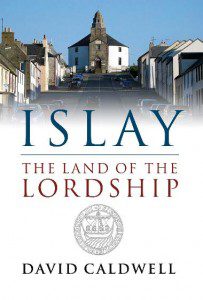Caldwell, D H. 2008 “Islay – The Land of the Lordship” Birlinn Ltd., ISBN 978-1-8415-8358-7, 396pp, 52 photographic illustrations, £30 hardback reviewed by Emeritus Professor Geoffrey Barrow
The profound and extensive knowledge of the beautiful south Hebridean island of Islay acquired by David Caldwell since 1988 is the basis of this attractive volume, beautifully produced by Birlinn. Chapter 2, on Prehistory and Early History, is the work of Alan Macniven. David Caldwell has written the rest, displaying a detailed interest in a wide range of the island’s history, from the twelfth-century Somerled, progenitor of MacRorys, MacDougalls and MacDonalds, through the Clan Donald Lordship of the Isles, to the dominance of the Campbells of Cawdor, the Campbells of Shawfield and later proprietors. Although chapter 11 is entitled ‘Emigrants and Visitors’ I can find no reference to Margaret Thatcher (Baroness Thatcher) whose fondness for holidays on Islay was well known. In many ways the most interesting chapters are 9 and 10 ‘Living on the Land’ and ‘Improving Ways’. These chapters give us much information on how the Illich (Islay folk) have lived from the sixteenth century to the present. The author is particularly interested in house types down the ages and has illuminating remarks concerning turf-walled houses which he believes may have been introduced to Islay by the Campbells of Cawdor in the seventeenth century. Clearly there is a need for extensive archaeology before we may fully understand the quality of peasant life in medieval and early modern Islay. Peasant farming involved the keeping of small black cattle and also sheep but apparently few pigs or goats. Fishing was obviously important but is poorly documented. What Islay is famous for world-wide is obviously the distilling of single malt whisky. Whisky distilling is documented from the early seventeenth century, but the frame of the output (from only seven distilleries, all household names) as a worldwide phenomenon is relatively modern. David Caldwell, who is well known for his archaeological investigations at Loch Finlaggan, is to be congratulated on writing an informative and wide ranging study, equal congratulations must go to the publishers for producing a well-printed, attractively presented book.
G.W.S. Barrow

